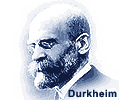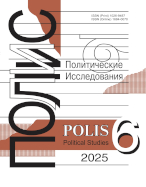Doctrinal symbolization and the political vernacular of narratives. What is changing in the public field?
Solovyov A.I.,
Lomonosov Moscow State University, Moscow, Russia, solovyev@spa.msu.ru
elibrary_id: 75920 |
Article received: 2024.09.30 12:56. Accepted: 2024.10.22 12:56

DOI: 10.17976/jpps/2025.01.06
EDN: SAGCFO
Solovyov A.I. Doctrinal symbolization and the political vernacular of narratives. What is changing in the public field? – Polis. Political Studies. 2025. No. 1. https://doi.org/10.17976/jpps/2025.01.06. EDN: SAGCFO (In Russ.)
The discursive diversity of public policy is constantly supported by a variety of symbolic structures used by the state, its partners and opponents, which formalize their political will in the form of various strategies, projects or individual actions. In modern conditions, with their characteristic uncertainty of the future and the volatility of their plans, political players, in an effort to increase the mobilization of the population, pay increasing attention to the communicative abilities of narratives that appeal to the mental characteristics of people, the ordinary level of their cultural orientations and everyday identification models. Compared with the doctrinal ways of symbolizing political goals and values, these narrative constructions retain significant advantages in interpreting and culturally decoding the meanings of political messages by people. Being a flexible and more accessible tool for the layman to purposefully influence a person’s awareness of the goals and values of the ruling regime, narratives extend not only to the public field, but are also actively used to convey meanings in intra-elite contacts, in which both status and informal coalitions of the ruling class participate. The widespread use of narratives inevitably leads to changes in the configuration of public discourse. At the same time, the methods of mass consciousness management are being updated both in countries of democratic deliberation and in states demonstrating various forms of authoritarian domination. The popular “concept of political narratives” (NPF), offering an essentialist interpretation of political narratives, introduces into the analysis a number of tools that allow to specify their place and role in the space of discourse, as well as to show the features of their application in the management of public communications of the state and society, emerging at all levels of the political system. Moreover, these cognitive constructions help to see certain trends in the evolution of the field of politics as a whole. Thus, modern realities clearly demonstrate that narrative politicians consistently strengthen the advantages of ruling regimes and lead to the solidification of manipulative forms of government, consistently expanding the mechanisms of political dominance hidden from society and shielding citizens from the levers of distribution of key public resources.
References
Berinsky, A.J., & Kinder, D. (2006). Making sense of issues through media frames: understanding the Kosovo crisis. The Journal of Politics, 68(3), 640-656. https://doi.org/10.1111/j.1468-2508.2006.00451.x
Bourdieu, P. (1989). Social space and symbolic power. Sociological Theory, 7(1), 14-25. https://edisciplinas.usp.br/pluginfile.php/3958155/mod_resource/content/1/Social%20space%20and%20symbolic%20power.pdf
Dunlop, C.A., Kamkhaji J.C., Radaelli C.M., & Taffoni G. (2021). The institutional grammar tool meets the narrative policy framework: narrating institutional statements in consultation. European Policy Analysis, 7(Suppl. 2), 365-385. https://doi.org/10.1002/epa2.1126
Edelman, M. (1985). The symbolic uses of politics. Urbana: University of Illinois Press.
Freeden, M. (2008). Thinking politically and thinking ideologically. Journal of political ideologies, 13(1), 1-10. https://doi.org/10.1080/13569310701828120
Gill, S.R. (1995). The global panopticon? The neo-liberal state, economic life and democratic surveillance. Alternatives, 20(1), 1-49. https://doi.org/10.1177/030437549502000101
Gramsci, A. (1971). Selections from the Prison Notebooks. London: Lawrence & Wishart.
Gronove, A., Satoh, K., Yla-Anttila, T., & Weible, C.M. (2023). Of devils, angels, and brokers: how social media position affects misconceptions about political influence. Journal of European Public Policy, 30(5), 898-921. https://doi.org/10.1080/13501763.2022.2046137
Hajer, M. (1993). Discourse coalitions and the institutionalization of practice: the case of acid rain in Britain. In F. Fischer, & J. Forester (Eds.), The Argumentative Turn in Policy Analysis and Planning (рр. 43-76). Durham; London: Duke University Press. http://maartenhajer.nl/upload/HAJER%20Arg%20Turn%201993.pdf
Jessop, B. (2019). Authoritarian neoliberalism: periodization and critique. South Atlantic Quarterly, 118(2), 343-361. https://doi.org/10.1215/00382876-7381182
Jones, M.D., & McBeth, M.K. (2010). A narrative policy framework: clear enough to be wrong? Policy Studies Journal, 38(2), 329-353. https://liberalarts.oregonstate.edu/sites/liberalarts.oregonstate.edu/files/economics/jones31oct2013a.pdf
Jones, M.D., McBeth, M.K., & Shanahan, E.A. (2014). Introducing the narrative policy framework. In M.D. Jones, E.A. Shanahan, and M.K. McBeth (Eds.), The Science of Stories: Applications of the Narrative Policy Framework in Public Policy Analysis (pp. 1-25). New York: Palgrave Macmillan.
Jones, M.D., & Radaelli, C.M. (2015). The narrative policy framework: child or monster? Critical Policy Studies, 9(3), 339-355. https://doi.org/10.1080/19460171.2015.1053959
Jones, M.D., & Song G. (2014). Making sense of climate change: how story frames shape cognition. Political Psychology, 35(4), 447-476. https://doi.org/10.1111/pops.12057
Jungrav-Gieorgica, N. (2021). Narrative Policy Framework - Public Policy as a battle of narratives. ResearchGate. https://www.researchgate.net/publication/353447369 Narrative Policy Framework
Kuenzler, J., & Stauffer, B. (2022). Policy dimension: A new concept to distinguish substance from process in the Narrative Policy Framework. Policy Studies Journal, 51(1), 11-32. https://doi.org/10.1111/psj.12482
Kuenzler, J., Vogeler, C., Parth, A.-M., & Gohl, T. (2024). Exploring the eternal struggle: The Narrative Policy Framework and status quo versus policy change. Policy Sciences, 57(3), 485-517. https://doi.org/10.1007/s11077-024-09537-6
Lejano, R., Ingram, M., & Ingram, Н. (2013). The power of narratives in environmental networks. Cambridge: MIT Press.
O'Bryan, T., Dunlop, C.A., & Radaelli, C.M. (2014). Narrating the “Arab spring”: where expertise meets heuristics in legislative hearings. In M.D. Jones, E.A. Shanahan, & M.K. McBeth (Eds.), The Science of Stories: Applications of the Narrative Policy Framework in Public Policy Analysis (pp. 89-106). New York: Palgrave Macmillan.
Ospina, S., & Dodge, J. (2008). Narrative inquiry. In Encyclopedia of Public Administration and Public Policy (рр.1285-1288). New York: Taylor and Francis.
Radaelli, C.M., Dunlop, C.A., & Fritsch, О. (2013). Narrating impact assessment in the European Union. European Political Science, 12(4), 500-521. https://doi.org/10.1057/eps.2013.26
Roe, E. (1994). Narrative Policy analysis, theory and practice. Durham; London: Duke University Press.
Roll, M. (2014). The politics of public sector performance: pockets of effectiveness in developing countries. London: Routledge.
Ruff, J.W.A., Stelmach, G., & Jones, M.D. (2022). Space for stories: legislative narratives and the establishment of the US Space Force. Policy Sciences, 55(3), 509-553. https://doi.org/10.1007/s11077-022-09455-5
Sabatier, P., Hunter, S., & McLaughlin, S. (1987). The devil shift: perception and misperceptions of opponents. The Western Political Quarterly, 40(3), 449-476. https://doi.org/10.1177/106591298704000306
Sabatier, P., & Jenkins-Smith, H. (Eds.). (1993). Policy Change and Learning: An Advocacy Coalition Approach. Boulder, CO: Westview Press
Schlaufer, C., Kuenzler, J., Jones, M.D., & Shanahan E.A. (2022). The Narrative Policy Framework: a traveler's guide to policy stories. Politische Vierteljahresschrift, 63(2), 249-273. https://doi.org/10.1007/s11615-022-00379-6
Shanahan, E.A., Jones, M.D., & McBeth, M.K. (2011). Policy narratives and policy processes. The Policy Studies Journal, 39(3), 535-561. https://doi.org/10.1111/j.1541-0072.2011.00420.x
Shanahan, E.A., Jones, M.D., McBeth, M.K., & Radaelli C.M. (2017). The narrative policy framework. In C.M. Weible, P.A. Sabatier (Eds.), Theories of the Policy Process (pp. 173-214). New York; Boulder: Westview Press. https://doi.org/10.4324/9780429494284-6
Tosun, J., & Schaub, S. (2021). Constructing policy narratives for transnational mobilization: Insights from European citizens' initiatives. European Policy Analysis, 7(S2), 344-364. https://doi.org/10.1002/epa2.1125
Truex, R. (2017). Consultative authoritarianism and its limits. Comparative Political Studies, 50(3), 329-361. https://doi.org/10.1177/0010414014534196
Weible, C.M., & Sabatier, P.A. (Eds.). (2018). Theories of the policy process (pp. 173-214). New York; Boulder: Westview Press. https://doi.org/10.4324/9780429494284
Kavtaradze, S. (2015). Arkhetipy voiny (nasilie, bessoznatel'noe i bor'ba za bazovye potrebnosti) [Archetypes of war (violence, the unconscious and the struggle for basic needs)]. Moscow: Homo erectus. (In Russ.)
Kirillov, A.G. (2007). Politicheskii narrativ: struktura i pragmatika: na materiale sovremennoi angloyazychnoi pressy [Political narrative: structure and pragmatics: based on the contemporary English-language press]. Dissertation for the degree of candidate of philological sciences. Samara: SGPU. (In Russ.)
Lunkin, R.N. (2023). Identizm: poiski novoj ideologii [Identism: the search for a new ideology]. In I.S. Semenenko (Ed.), Identichnost‘: lichnost‘, obshchestvo, politika. Novye kontury issledovatel'skogo polya [Identity: The Individual, Society and Politics. New Contours of the Researched Field] (pp. 242-249). Moscow: Ves' Mir. (In Russ.)
Malinova, O.Yu. (2012). Symbolic politics. Contours of the problematic field. Simvolicheskaya politika, 1, 5-16. (In Russ.)
Malinova, O.Yu. (2023). Simvolicheskaya politika [Symbolic politics]. In A.I. Solovyov (Ed.), Politologiya. Novyi Leksikon [Political Science. New Lexicon] (pp. 273-279). Moscow: Aspect press. (In Russ.)
Musikhin, G.I. (2013). Methodology of ideological research: from behavioral analysis to poststructuralist contextual models. Simvolicheskaya politika, 4, 11-30. (In Russ.)
Musikhin, G.I. (2024). Narrative as a meaning-forming element of political symbolization. Voprosy teoreticheskoy ekonomiki, 2, 116-133. (In Russ.) https://doi.org/10.52342/2587-7666VTE_2024_2_116_133
Mchedlova, M.M. (2023). Tsivilizatsionnye narrativy v politicheskom diskurse: tsennosti i smysly [Civilizational narratives in political discourse: values and meanings]. In I.S. Semenenko (Ed.), Identichnost: Lichnost, obshchestvo, politika. Novye konturi issledovatelskogo polya [Identity: The Individual, Society, and Politics. New Outlines of the Research Field] (pp. 165-174). Moscow: Ves' Mir. (In Russ.)
Podshibyakinа, T.A. (2021). Strategic narratives as a soft power political resource: the Immortal regiment on guard of the interests of Russia. Bulletin of Perm University. Political Science, 15(3), 52-59. (In Russ.) https://doi.org/10.17072/2218-1067-2021-3-52-59
Potseluev, S.P. (1999). Symbolical politics: a constellation of concepts for an approach to the problem. Polis. Political studies, 5, 62-75. (In Russ.)
Potseluev, S.P. (2012). Symbolic politics. Contours of the problematic field. Simvolicheskaya politika, 1, 17-53. (In Russ.)
Prokhorov, Yu.E., & Sternin, I.A. (2011). Russkie. Kommunikativnoe povedenie [Russians. Communicative behavior]. Moscow: Flinta-Nauka. (In Russ.)
Sheigal, E.I. (2007). The many faces of narrative. Political linguistics, 22(2), 86-93. (In Russ.)
Solovyov, A.I. (2016). Trust as an object of political sociology. Part II. Polis. Political studies, 2, 90-108. (In Russ.) https://doi.org/10.17976/jpps/2016.02.08
Uldanov, A.A. (2024). Policy narratives in parliamentary debates: approaches to analyzing narrative elements, functions, and strategies. Political Science (RU), 3, 66-86. (In Russ.) https://doi.org/10.31249/poln/2024.03.03
Zavershinskiy, K.F. (2021). “Generations of elites” vs “elite of generations”: communicative dimensions ofpolitical elite's socialization. Vlast' i elity [Power and Elites], 8(1), 123-147. (In Russ.) https://doi.org/10.31119/pe.2021.8.1.5
See also:
Safranchuk I.A., Zhornist V.M.,
Dominant narratives in Western media during the 1990s formation of the Responsibility to Protect. – Polis. Political Studies. 2025. No2
Gavrilova M.V.,
Explication of politician’s ideological representations: linguistico-cognitive approach. – Polis. Political Studies. 2010. No3
Martynov M.Yu., Fadeyeva L.A., Gaberkorn A.I.,
Patriotism as Political Discourse in Contemporary Russia. – Polis. Political Studies. 2020. No2
Bereznyakov D.V., Kozlov S.V.,
Symbolic Politics in Post-Soviet Ukraine: Construction of the Legitimizing Narrative. – Polis. Political Studies. 2015. No4
Kyrchanoff M.V.,
Image of China as an anti-Muslim “Other” in the Indonesian media. – Polis. Political Studies. 2024. No1




.jpg)






 print
print
.jpg)
.jpg)